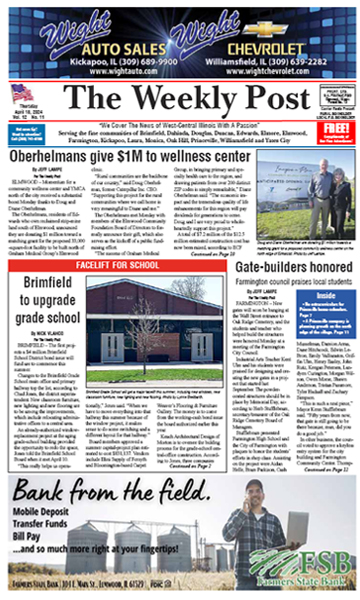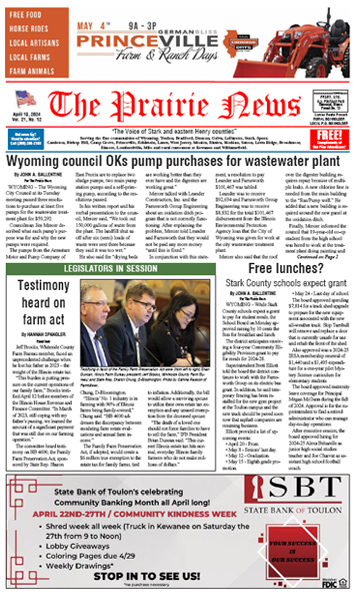By BILL KNIGHT
After pandemic precautions, some places are reopening due to public concerns or political pressure, and there’s cautious optimism.
Local politicians were even scheduled to gather in Peoria Wednesdaymorning to announce a proposed Heart of Illinois SubRegion Reopening Plan (See story, here).
However, pitfalls remain, ranging from new outbreaks to legal liability. Despite not meeting White House guidelines on testing, tracing, treating/quarantining, dozens of states and a few communities are relaxing requirements or defying orders (such as East Peoria and Woodford County), with others possibly lifting restrictions. In Illinois, Gov. JB Pritzker’s “Restore Illinois” plan has five phases to proceed, with standards to meet before the next step.
“This plan looks to reopen portions of Illinois based on specific regional health-care data and capacity to care for an individual should they become ill,” said State Rep. Jehan Gordon (D-Peoria). “ICU capacity, positivity rates, contact tracing, mass testing, etc., will determine how quickly regions begin to reopen.”
Optimists hope recovery can be as quick as the economy was in its decline. Last month, U.S. payrolls dropped by 20.5 million jobs, 33 million jobs have been lost in seven weeks, the unemployment rate is 14.7 percent, and government aid has been insufficient. As a result, people have become frightened to be without income – as well as scared of infection.
“From my experience in banking, I know how difficult it can be when you get behind financially,” says Farmington Mayor Kent Kowal. “If there’s no income for two months, it snowballs. It’s hard to catch up. We don’t want to see situations where people just throw up their hands and lock the doors and quit.” Of course, struggling finances can eventually be improved; death can’t, and health experts warn that opening too soon could let the virus rebound with deadly results.
“If we relax these measures without having the proper public-health safeguards in place, we can expect many more cases and, unfortunately, more deaths,” said Josh Michaud, associate director of global health policy with Kaiser Family Foundation.
Physicians say it can be 14 days after COVID-19 exposure before symptoms arise, so there are concerns people will let up on the vigilance that’s helped “bend the curve” of new cases. Last week, researchers at Columbia University’s Department of Environmental Health Sciences projected that COVID-19 cases and deaths will rise significantly if more states continue to lift shelter-in-place orders and reopen businesses, and the Institute for Health Metrics and Evaluation at the University of Washington added, “Rising mobility as well as the easing of social-distancing measures indicate growing contacts among people will promote transmission.”
Beyond illness, there are consequences to companies and local governments that defy state orders. They could face lawsuits, according to the Illinois Trial Lawyers Association, whose president Antonio Romanucci in a prepared statement said, “The prudent course would be to stay closed for another 25 days and limit any further potential spread which could lead to litigation.”
Further, such municipalities and employers might not be covered by insurance. Insurance policies are “not going to cover intentional acts,” Illinois Insurance Association director Kevin Martin told columnist Rich Miller, and the Illinois Restaurant Association and Illinois Retail Merchants Association urged businesses to comply with orders.
Some officials have said it’s worth the sacrifice of some people dying if that means the country’s economy bounces back, a perspective rejected by emergency physician Leana Wen of the Milken Institute School of Public Health at George Washington University. “This is a false choice; there are ways to safely reopen, and consumer confidence depends on the reassurance of public-health protections,” Dr. Wen said.
Bob Senneff of Graham Hospital in Canton agrees that a safe reopening in stages can be done. “It’s very possible if we do what we’ve been doing, like with masks,” he says. “We have to open logically and intelligently. We don’t want to think the ‘fire’is out and then end up throwing gasoline on it. Then we get 50 positives. We don’t want that; that’d kill us. We have to think things through.”
Kowal says reopening probably won’t be a quick fix. “I think it’s going to be a slow thing,” he says. “People are going to be wary for a long time [and] the feeling is pervasive. I’ve had people tell me until there’s a vaccine, they won’t go to church or movies or Spoon River Drive or anything with a crowd.” The nation’s top infectious disease official, Dr. Anthony Fauci, on May 3 said, “It’s the balance of something that’s a very difficult choice, like how many deaths and how much suffering are you willing to accept to get back to what you want to be, some form of normality, sooner rather than later?”
In Princeville, the Village Board declined to sign off on a reopening plan with area municipalities but plans to discuss it at its next May 19 meeting. “I think we wanted to give it a few weeks,” says Village president Jeff Troutman. Pritzker’s got “a decent plan. It depends on what we do in the next 19 days or so. I could see the restaurant and bakery benefiting some even if they were at 50 percent capacity or whatever. I don’t know about the bars.”
At the Knox County Health Department, Erin Olson says, “We continue to encourage people to practice social distancing, wear face coverings, clean, cover coughs, not have social gatherings, and just be courteous to others.”
Illinois Chamber of Commerce president Todd Maisch said Pritzker’s plan is too slow, and some Illinois Republican officials – who’d supported stay-at-home measures – oppose the plan’s regional division.
Kowal agrees, saying, “We don’t belong with Rockford or the Quad Cities,” and in Galesburg, Olson, of the Knox County health department, says that it’s hard to look at the pandemic just by geographic boundaries. “It’s not always as simple as that,” she says. “I live in Mercer County, and I drive to work through Warren County, and I work in Knox. [But] there is a plan and everybody’s also looking at IDPH and CDC plans.”
Illinois Department of Public Health director Dr. Ngozi Ezike conceded that COVID-19’s spread varies from place to place. “It’s not uniform across the state, and we understand that,” she said. “And so that’s why we’re looking very closely, every day, multiple times a day, just to figure out where we’re at and figure out who’s going up in what dimension, who’s going down in the other dimension at what rate.”
On Sunday, Pritzker defended the methodical approach. “We are being very careful,” he said. “We’ve done a lot to make sure we’re keeping these numbers moving in the right direction. And we will not reopen unless we meet all of the standards. Coronavirus is still out there … And so we all are going to have to change the way we do things until we’re able to eradicate it.”
Most Illinoisans support safety mandates, but few back reopening anytime soon, according to polls. Social distancing is supported by 98 percent of Democrats and 82 percent of Republicans, according to ABC/Ipsos, and a poll from Harvard, Northeastern and Rutgers universities showed that 69 percent of Illinoisans approve of Pritzker’s handling of the outbreak, and just 8 percent think Illinois’ businesses should reopen right away. Another 9 percent said a couple of weeks; 18 percent said up to a month; 20 percent said four to six weeks; and 19 percent said six to eight weeks.
“This is definitely a big problem,” says Sen. Dave Koehler, a Peoria Democrat. “That’s why stimulus money is so important and why we need help from the federal government. Koehler backs Pritzker’s plan but recognizes people’s challenges and frustrations. “We’re at a different place,” he says. “We have to manage our own destiny [and] be science-based.
This is a life-altering event. It will change how we do things.” Ezike said Illinoisans might focus frustrations on the virus. “Everybody wants us to get back to normal,” the doctor said. “I think we are sending some of the frustration toward the wrong entities. You should be sending it toward the virus. And then we should all see how we can support ways to find cures.”
“There’s a health-care crisis and an economic crisis,” Koehler says. “We unfortunately may experience one or the other; or worse, both.”
BILL KNIGHT can be reached at bill.knight@hotmail.com
Copyright © 2023 illinoisweeklies.com







